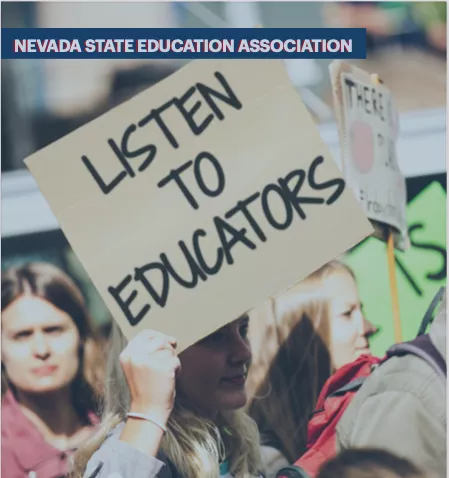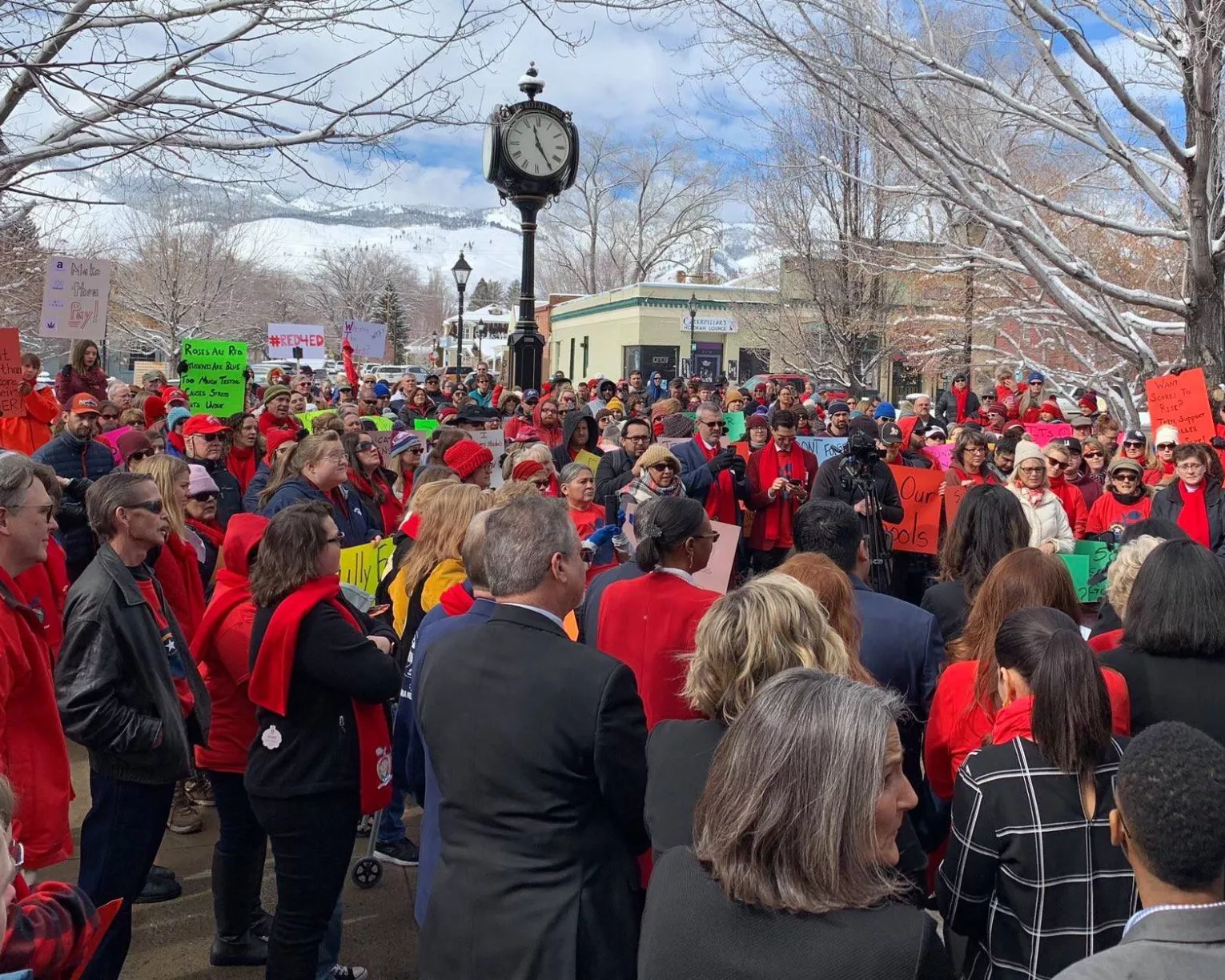Clark Retired Educators Association March 2021 Newsletter

RED FOR ED BRINGS EDUCATORS TOGETHER TO IMPROVE EDUCATION

At last month’s President's Day Red for Ed rally in Las Vegas and Carson City on February 15, concerned educators, students, parents, and community members donned their warmest red clothes and demonstrated their support for public education.
Here in Las Vegas, CREA made a good showing at the Grant Sawyer Building where about 75 people demonstrated for prioritizing education and education funding this legislative session. However, in Carson City two to three hundred people showed up holding signs and chanting for change.
The demonstration was organized by the Nevada State Education Association, but they were joined by Battle Born Progress, the Progressive Leadership Alliance of Nevada, Mi Familia Vota, Faith in Action, and the Culinary Workers Union, among many others.
Red for Ed is a grassroots wave powered by social media that has swept across the country and brought educators onto the streets and into state legislatures to demand better pay and resources.
Although the Red for Ed movement seems to have been around a lot longer, it actually began only three years ago. It started in West Virginia in February, 2018 when educators demonstrated against low salaries and increasing health care costs.
Their victory in Vest Virginia then prompted educators in other states, generally states controlled by Republican legislators, to begin their own Red for Ed movements. By April of 2018, Red for Ed protests had sprung up in Oklahoma, Kentucky, Arizona, and Colorado.
In 2019, educators in many other states, including those run by Democratic legislatures, began putting together their own Red for Ed demonstrations.
Before the Red for Ed movement, teachers were largely being blamed for education problems, but after the protests started, the public became aware that state legislatures were at fault because of slashes they had made to education in the wake of the 2008 recession.
Red for Ed calls for more money for education, better teacher salaries, more affordable health care, and smaller class sizes.
Although taking part in these actions has dramatically raised educators’ expectations for improvements in education, there is only so much that protests can do to reverse decades of public school neglect.
The National Education Association says educators make only 80 percent of what other paid professionals with the same credentials are making in other fields. Meanwhile, teachers spend over 450 dollars every year for needed school supplies, and nearly a third of all educators must take a second or third job to stay financially afloat.
The Red for Ed movement helps educators advocate to make our schools the best they can be for every student. By standing together in a large, very visible red group, educators create much larger voice than by working alone to advocate for schools and for public education.
NEW CREA ELECTIONS TO BE HELD

The COVID-19 pandemic has made governing CREA quite challenging. Since April last year when large gatherings were outlawed, CREA could not form a large enough group to vote for new officer positions or even to accept nominations.
Part of the problem was that CREA bylaws did not include electronic nominating and voting, but the board is currently changing those bylaws to make electronic voting possible. Those who cannot vote electronically will be sent a nominating form and a ballot by mail.
Nominations will be held in much the same way as NSEA-Retired recently held theirs. Nominating forms will be sent through email using people’s email addresses, but forms will also be mailed to those who request them.
Following nominations, elections will be held, and the names of eligible candidates will appear on the ballot. The election will be held the same way as nominations. Ballots will be sent to members’ email address unless they request a paper ballot, in which case one will be mailed to them.
So which CREA board positions are up for election? All of them. Elections were not held in 2020 because of the pandemic, and board members simply kept their positions until new elections could be held. Since all board positions are two-year terms, every CREA board position will be available for nominations.
We will be taking in names for president, vice president, treasurer, secretary, and eight board positions. If you or someone you know has wanted to run for the CREA board, the timing could not be better.
There is a very good chance that CREA could once again meet in person in the fall. It would be great to have a new board in place to begin the 2021 to 2022 CREA year.
NSEA BILL TRACKER

The 81st Session is well underway and while the entire session has been conducted virtually thus far, NSEA has introduced a great way for members to stay up to date about what’s going on! With NSEA’s Bill Tracker, you'll find information, positions (which are subject to change based upon amendments), and memos on the bills NSEA is tracking and testifying on. They have also built in a great way to email the NSEA Ground Team if you have any questions about any of the bills being tracked. You’ll find email form at the bottom of the webpage. CLICK HERE for the NSEA Bill Tracker.
CREA SPEAKER TALKS ABOUT COVID-19 & VACCINES
Last month’s presentation via Zoom about COVID-19 and vaccinations for those over 70 by Dr. Chad Kingsley of the Southern Nevada Health District was very informative and insightful. CREA even helped the health district fix a problem they had with appointments not being cancelled.
WHEN Dr. Kingsley spoke last month, vaccination appointments were being made only for those over 70. The age limit has now been lowered to 65.
One of the more sobering things Dr. Kingsley had to say was that other serious health problems can kill those who have come down with COVID-19, even after the disease has left their bodies. He said one in every eight people is likely to die from health problems they already had before they contracted the disease, but which the COVID-19 infection made worse.
Dr. Kingsley stressed that COVID-19 is not a disease people want to contract to “get it and get it over with” like measles. There are just too many lingering symptoms, he said, like fatigue and a loss of taste and smell, although Kingsley did say that some people lose those symptoms after they have taken the vaccine.
Kingsley said that fully one-third of those who have had COVID-19 become long-haulers, but he added that no one seems to know just how long people can still harbor the effects of the disease after the disease leaves their bodies.
Kingsley was asked about whether seniors should get the two-dose Pfizer or Moderna vaccine or the one-dose Johnson and Johnson vaccine, and he said that the two-dose vaccines provide better protection for older Americans.
Kingsley stresses that those who have been vaccinated still need to take precautions like social distancing and wearing masks to keep from spreading the virus to others, but he said that most people should be protected from getting the virus themselves two weeks after their second injection. He said the Center for Disease Control currently cautiously claims the vaccination is good for three months, but he said those projections will probably be stretched to six months and then longer as more is known about the vaccine and about COVID-19.
When the vaccine is distributed world-wide, Kingsley said the odd strains of COVID-19 that have proved so worrying should stop mutating. Kingsley predicted that by September the country’s mask mandate will finally be gone.
After last month’s meeting was over, Dr. Kingsley continued to follow up a comment made by one of our CREA members. During the meeting, he told Kingsley that a SNHD operator had told him she could make new appointments but could not cancel previously made appointments. Kingsley checked and discovered FEMA operators did not have a way to cancel appointments, so he changed how cancellations were being handled so that when people called in, their cancellations were made.
A new system has since been implemented at the Southern Nevada Health District which has taken care of that problem.
THE 39 YEAR EXPERIMENT THAT COULD HELP RETIREES
By Steve Horner
During the height of World War I, the federal government needed to establish a statistical method to track prices of items on which the public was spending their money each month. The items were broken into certain groups, and those groups were placed in a “market basket.” Those items were tracked over several urban centers with working groups that were working within those urban settings. Then, by averaging the prices and the groups’ spending habits, the government could track inflation and which items were contributing to inflation. That is a simple explanation of how and why the Consumer Price Index (CPI) was created.
Since 1919 there have been many manifestations and refinements made to system, but overall, the system still works for its intended purpose, to track prices and spending habits.
In this article we are going to examine two subsets of the CPI: Consumer Price Index for urban wage earners and clerical workers (CPI-W) and Consumer Price Index for the elderly (CPI-E). Social Security and many pensions’ cost of living adjustments (COLAs) are made using CPI-W; however, in 1982 an amendment to the Older American Act of 1965 forced the Bureau of Labor Statistics (BLS) to establish an experimental index, CPI-E, to track the spending and costs for Americans 62 and older. Thirty-nine years later CPI-E remains experimental.
The “market basket” for both CPI-W and CPI-E are the same. They include housing, transportation, food and beverages, medical care, education and communication, apparel, and things that do not fit in the other groups.
Each month the BLS collects the data they need. Then they weigh the categories against the overall money spent. Organizations or governments use that information for COLAs and raises. Social Security continues to use CPI-W even though CPI-E has shown that seniors spend their money much differently than urban workers and that many costs are much higher for retirees, especially medical costs and housing.
Side by side comparisons since 1984 show CPI-E averages about .27% higher each year. Over several years that could make significant differences for seniors who spend so much more on medications and housing than regular wage earners. According to a November, 2019 article in the Senior Citizens League, if the BLS had been using CPI-E since 2015, the overall increase for Social Security COLAs would have been $26 dollars a month. Although it is not huge each month, over time it becomes significant.
BLS continues to refer to the CPI-E as experimental, and the Government Accountability Office questions its accuracy because of a limited sample size. Even so, over 39 years, both the BLS and GAO have had ample time to make the corrections need to refine the status of CPI-E from “experimental” to a truly verified Index.
The CPI-E is not a magic bullet, nor will it provide huge increases in COLAs, but it begins to address the real needs of persons over the age of 62. Seniors’ spending patterns are different, and our COLAs should be based on those differences. Perhaps it is time for Congress to allocate the money so the BLS and GAO can complete the research needed to determine whether they should recommend that CPI-E be used to calculate seniors’ COLAs going forward.
States would also be freer to examine how using CPI-E could help those individuals in each state’s public employee retirement system. So many seniors must make hard economic choices because medical supplies and services are becoming more expensive, but our Social Security and pensions are not keeping up. Ignoring the difference between the indexes will not address the real needs of those who have retired.
We have briefly explained a complex subject, but the issue remains simple. Retirement should not mean our cost of living increases remain the same as those who have not retired. Perhaps CPI-E is not the ultimate answer, but it is time to stop calling in experimental. If more work needs to be done to finally complete the experiment, the work should start, and better cost of living remedies should be found. Thirty-nine years is long enough.
FOOD DRIVE PLANNED FOR MARCH CREA MEETING

CREA will be collecting donated food from our members and their friends at a drive-thru food drive for the March 11 CREA meeting instead of conducting a meeting through Zoom.
This month’s drive-thru food drive will be very much like the toy drive we held in December when we collected toys in our drive-thru Christmas toy drive.
The drive-thru food drive will start at the regular 10:00 a.m. meeting time, and board members will be in the parking lot to accept donations from CREA members until noon.
CREA members and friends will drive into the Las Vegas NSEA parking lot at 3511 East Harmon Avenue where they will be greeted by masked members of the CREA board who will receive their food donations.
CREA members can donate canned goods, non-perishables, or money. Cash is always welcome because it allows food banks to purchase items they do not have. Our members’ food donations will go to the United Labor Agency of Nevada.
Here are some suggestions for donations, and not all of them are food:
- Meal kits that are complete and require no extra ingredients
- Pancake and muffin mix that works with only water
- Canned soups, pasta meals, and meats. Low sodium is especially appreciated.
- Basic staples: flour, sugar, rice, cornmeal, dry beans, oil, baking soda and baking powder
- Low-sugar cereals
- 100% fruit juice, not drinks high in corn syrup
- Get pop-top lids when possible. Not everyone has a can opener.
- Salt and pepper and cooking spices like garlic powder and onion powder
- Baby things like diapers, wipes, diaper rash cream, baby wash, and baby food
- Household staples like soap, dish soap, paper towels, toothpaste, and deodorant
- Household cleaning supplies like bleach and sanitizing solutions
- Feminine hygiene products
- New socks and underwear
Here are suggestions about what NOT to donate:
- Expired items from your pantry
- Canned meats like sardines or potted meat blends. Most kids do not like them.
- Items that need refrigeration
- Foods with packaging problems like torn boxes or dented cans
References
Downloads
Learn More
Do More
What's On Your Mind?



